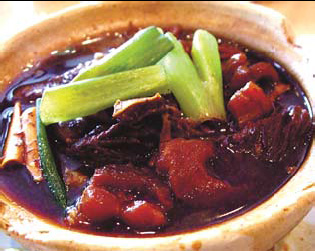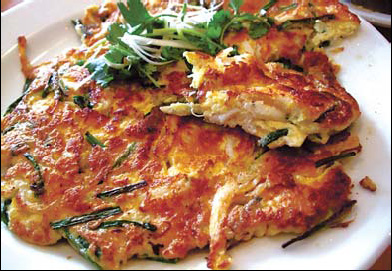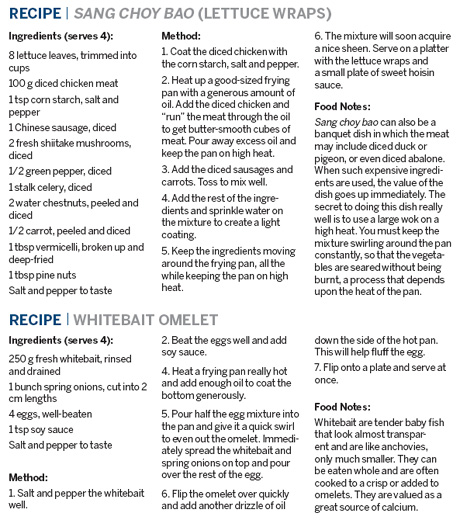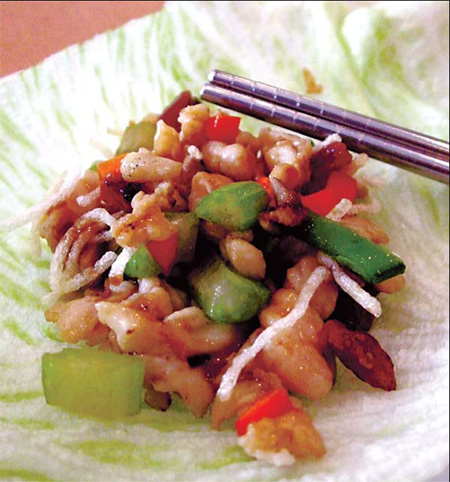Staying true to their roots

|
Adelaide's Chinatown offers some true Chinese home-cooking dishes, such as beef belly and tendon stew (top), lettuce wraps (above) and whitebait omelet (below). Photos by Pauline D Loh / for China Daily |

The Chinese are widespread throughout the world, and where there are people, there's food. Pauline D Loh looks at how they eat Chinese in Adelaide, currently host of the country's most prestigious food festival
Adelaide is the food city of the moment. International chefs and local celebrities are gathered in this capital city of South Australia to celebrate Tasting Australia, one of the country's largest and most popular food festivals.
For a full 10 days, culinary media from all over the world will explore, experience and appreciate the food, wine and fresh produce from the region, including the seafood sanctuaries of Limestone Coast, Murray River Basin and the Eyre Peninsula and the wines from the famous Barossa Valley.
However, on the day we arrived, three Asian journalists decided to explore the Chinese food in the city. We began by checking out the broad aisles of Central Market, gasping at the huge array of fresh vegetables - aubergines the size of a football, tomatoes ruby red and busting with juices, huge green avocadoes with a shiny sheen on their skins, huge mandarins, polished brown chestnuts, red peppers, green peppers, yellow corn on the cob - it was a real feast for the eyes, and it wasn't long before we began to feel hungry.
Next stop Chinatown. As we walked down Gouger Street just outside Adelaide's Central Market, we were amazed at the number of quality Chinese, Thai and Vietnamese restaurants along the stretch.
We finally settled on Wah Hing, a Chinese restaurant that was very neat, very modern, very clean and filled with native Cantonese speakers. Its credibility established, we settled down to explore the menu, which looked almost identical to those in Hong Kong, though there were certain telltale clues that we weren't in that city. First, spring rolls topped the appetizer list, followed by sang choy bao (lettuce wraps) and prawn toast - standard Chinatown offerings in Australian cities that are only marginally better than bastardized chop suey.
Australian Chinatowns love these lettuce wraps and restaurants from Perth to Sydney, to Melbourne to Adelaide, list them in their menus with loving dedication. The same thing goes for paper-wrapped chicken, or gee pow gai as it is translated here.
In American Chinatowns, wanton dumplings, long soup and short soup would be accorded the same favors.
But Wah Hing did surprise us with some true Chinese home cooking, including a jelly-soft beef belly and tendon stew and a fluffy whitebait omelet that we all enjoyed tremendously.
The Australian portions were enormous. The lettuce wraps, especially, came with four bowl-sized lettuce leaves, a far cry from the dainty cups we are more used to in the Chinese eateries in Hong Kong, Shanghai or Beijing. The finely diced filling was a tasty blend of Chinese sausages, water chestnuts, diced chicken, celery and green peppers. It was savory and sweet at the same time and made a pleasant appetizer.
Next came the beef stew served up in a battered claypot that displayed its pedigree. The bubbling stew was slightly sweet, but the beef belly was chopstick tender, as were the almost transparent tendons, which were braised to gelatin-softness.
But the highlight of our meal was the dish recommended by Wah Hing's lady manager - a golden omelet stuffed with snowy white baby fish and slivers of jade-green spring onion and chives.
Our experience at Wah Hing convinced us that the new chefs abroad are staying faithful to their culinary heritage and that chop suey and sweet and sour pork can finally be put to rest in Chinatown restaurants as Chinese food has now gained a much wider acceptance in Western societies.

(China Daily 05/08/2010 page12)















